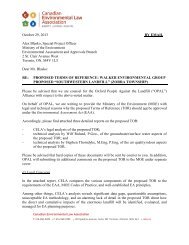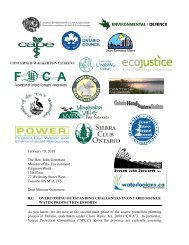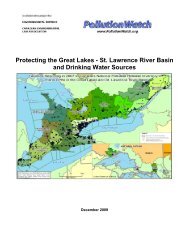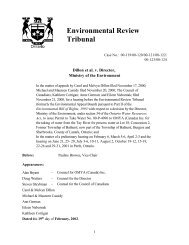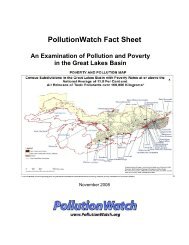H2Ontario - Version 2.0 - POLIS Water Sustainability Project
H2Ontario - Version 2.0 - POLIS Water Sustainability Project
H2Ontario - Version 2.0 - POLIS Water Sustainability Project
- No tags were found...
Create successful ePaper yourself
Turn your PDF publications into a flip-book with our unique Google optimized e-Paper software.
Provide Leadership, Direction and AccountabilityPriority 2: Targets and PlansProvincial TargetAn overarching water conservation target is necessary to send a clear signal to the province as a wholethat conservation and efficiency are essential to our continued economic and ecological health.Naturally, there are challenges associated with setting overarching targets, especially in the absence ofsolid baseline information on existing water use and the potential for water savings in each sector. Yetin spite of these challenges, a target provides incentive for change and a benchmark with which togauge progress. Adopting a vision of No New <strong>Water</strong> Supplies, until all practical water conservation andefficiency has been achieved, inspires a paradigm shift towards water conservation without using anabsolute or percentage reduction target that may be difficult to quantify.Action 2: Implement a Provincial Target of No New <strong>Water</strong> SuppliesEstablish a water conservation target of No New <strong>Water</strong> Supplies for the entire province to communicate to allOntarians that the government is willing to provide the “leadership” necessary to advance a culture of waterconservation.<strong>Water</strong>shed-Based TargetsFrom an ecological perspective, the most appropriate scale for water conservation and efficiencytargets is the watershed. Depending on the number, size, and type of withdrawals, as well asprevailing geophysical and climate conditions, certain watersheds will face more water stress thanothers. Tailoring conservation targets to the level of stress within Ontario’s watersheds is the mosteffective way to respond to the needs of the ecosystems that depend on healthy rivers, lakes, andaquifers.Ontario is well positioned to initiate development of watershed-based maximum water withdrawallimits. The creation of water budgets under the Clean <strong>Water</strong> Act provide the necessary basis for settingboth maximum water withdrawal limits and targets for water conservation and efficiency at awatershed level. Targets should be ecologically relevant, and watersheds under known water quantitystress should be required to reduce water use immediately from current levels to avoid unknown andpossibly cumulative consequences of long term failure to meet ecological needs.A comprehensive watershed assessment of ecological needs for water would also be necessary toaccurately assess a sustainable level of water withdrawals. A number of Conservation Authorities arealready well-placed to assist the Province with identifying instream flow needs, provided they are giventhe resources and support to undertake these studies. The Province must provide sufficient resourcesfor this effort, and make hydro-geologic studies and data available to stakeholders to avoidredundancy.<strong>H2Ontario</strong>: A Blueprint for a Comprehensive - 16 -<strong>Water</strong> Conservation & Efficiency Strategy



